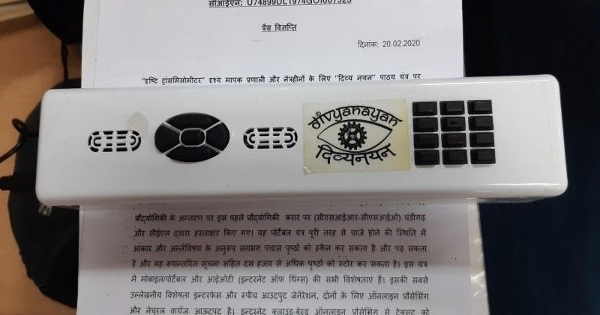New Delhi: Nearly 4.7 million people in India are blind or visually impaired, this physical disability keeps them away from many things, one of which is, reading. To make them self-dependent, the Central Scientific Instruments Organisation (CSIO), Chandigarh, has developed a scanner-based reading device called ‘Divyanayan’. CSIO is a part of the Council of Scientific and Industrial Research (CSIR).
It is a reading machine for the visually impaired and illiterate people, where any printed or digital document can be accessed in the form of speech output. The device uses a contact line scanner for acquiring the image of a printed document.
“Earlier we were thinking to make it a camera-based device but then it would have been difficult for a visually impaired person to click a perfect picture, so we thought of a scanner-based device which is more viable,” said Dr RK Sinha, Director, CSIO.
Depending upon the size and content, this personalized portable device can scan and read approximately fifty pages. The user has to manually scan the document by placing the device on a printed document without knowing the direction of text flow, moving the device over the document to be read. It has two keypads, one is used for the operations and the other has functions like cloud connectivity, saving a file name, use of a pen drive and others.
It uses optical character recognition technique to convert the image into text, and a text to speech converter further converts the text into audio. Audio files are organized in the machine and can be accessed whenever the user wants to listen to it. The device is standalone, portable, completely wireless and internet-enabled. It is equipped with an internal speaker, rechargeable battery, USB, headphones, SD card, Wi-Fi and Bluetooth.
“It is available in seven Indian languages and soon we will increase it to 10-12 languages. It uses an Indian accent for all its languages. The speech rate can be increased by the user,” said Dr Sinha.
Recently, the technology of Divyanayan has been transferred to Central Electronics Ltd (CEL). “By the end of March we will make 100 pieces and within 2-3 months it would be there in the market,” said BR Sarkar, Director, CEL.
Source: Indus Dictum
Image Courtesy: Indus Dictum
You may also like
-
New Heat-Based Approach To Cancer Treatment Can Reduce Chemotherapy Doses
-
Scientists Take A Major Step Towards Unification Of Classical & Quantum Gravity
-
India Graphene Engineering and Innovation Centre (IGEIC) Under the Vision of Viksit Bharat@2047 Launched
-
New High-Performance Gas Sensor can Monitor Low Level Nitrogen Oxides Pollution
-
Antidepressant Drug can be Repurposed for Treating Breast Cancer
